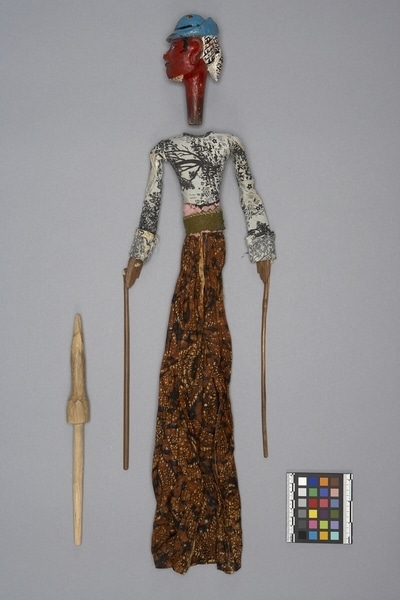Rod Puppet Item Number: Ib312 from the MOA: University of British Columbia


Description
Three-dimensional male humanoid puppet: large head (part b) fits into body with skirt (part a), and a control rod (part c) with a long shaft passes through the body and fits into the neck of the figure's head. The body has jointed arms, each with a long controlling rod attached. Large head and jointed arms attached to controlling rods. Red face with incised features, facing forward. Eyebrows, sideburns, moustache, lips and beard outlined in black; white eyes. Blue small-brimmed hat folded up at rear. Black banded crown of hat parted lengthwise at centre. White, black, and red bundle at base of head (kerchief?). Slim body and shoulders; fingers held flat, hands bent back at wrist. Upper torso covered in grey and black patterned cloth with black velvet (synthetic?) sewn to chest area. Pink lace beneath a green waistband. Long batik skirt with pattern in black, brown and beige.
History Of Use
Javanese puppetry as an art form probably developed by the 11th century. Wayang golek puppets of western Java appeared during the 16th century. Originally the plays depicted Javanese mythology, but after the Indian conquest of Java the Hindu epics, Ramayana and Mahabharata, were incorporated into the cycles, which comprise about 200 plays. A dalang (puppet master) performs the plays to celebrate important occasions, usually in three acts, with vocal and instrumental accompaniment. Typically they serve a moral and religious purpose, and more recently, one of political commentary. Character's role not identified; possibly used for secondary roles, such as prince or priest.
Cultural Context
Theatrical performance.
Iconographic Meaning
Each puppet is characterized by it's wanda, a Javanese word which describes the specific mixture of elements of size, form, colour, ornamentation and carving. Red face, position of face suggests aggressiveness or assertiveness. Small features somewhat refined, as is body shape and size. Hat, garments appear non-traditional, except for batik skirt, which indicates rank. Puppet not identified; possibly a modern addition or a creation of the carver.
Item History
- Made in Java, Indonesia
- Owned by Tradewind Antiques before March 15, 1983
- Received from Museum of Anthropology Shop Volunteers (Funding source) and Tradewind Antiques (Seller) on March 15, 1983
What
- Name
- Rod Puppet
- Identification Number
- Ib312
- Type of Item
- puppet
- Material
- cotton fibre, synthetic fibre ?, paint, fibre and wood
- Manufacturing Technique
- carved, painted, tied, woven and sewn
- Part A
- height 51.5 cm, width 11.5 cm, depth 4.5 cm
- Part B
- height 12.5 cm, width 6.5 cm, depth 7.5 cm
- Part C
- height 27.8 cm, diameter 2.7 cm
Who
- Culture
- Sundanese
- Previous Owner
- Tradewind Antiques
- Received from
- Museum of Anthropology Shop Volunteers (Funding source) and Tradewind Antiques (Seller)
Where
- Holding Institution
- MOA: University of British Columbia
- Made in
- Java, Indonesia
When
- Ownership Date
- before March 15, 1983
- Acquisition Date
- on March 15, 1983
Other
- Condition
- fair
- Accession Number
- 0886/0046